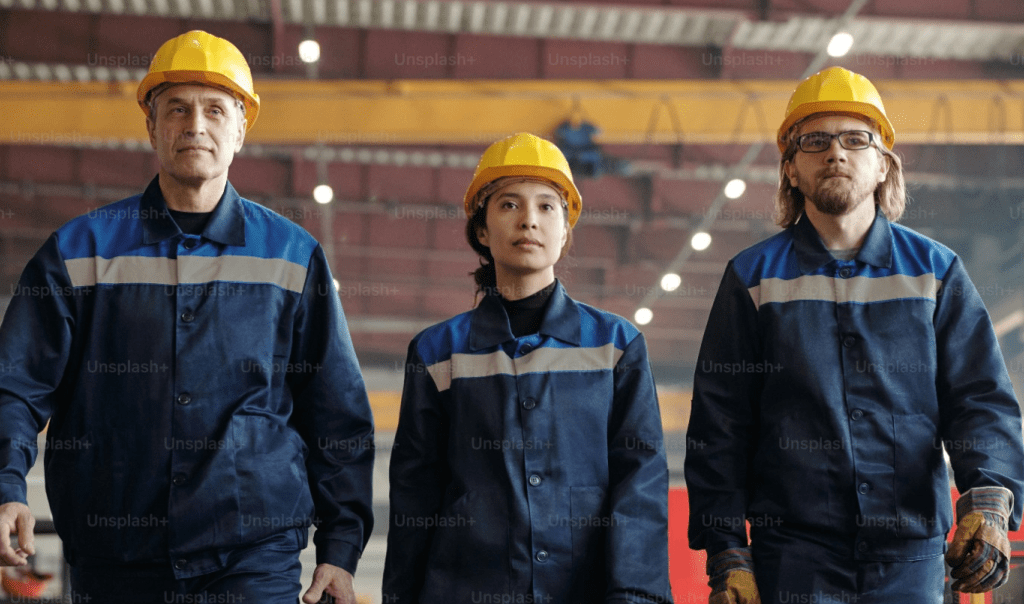Get a Free WorkTrek Demo
Let's show you how WorkTrek can help you optimize your maintenance operation.
Try for freeWhat is the best way to define the role of the maintenance team in your facility? Your facility maintenance professionals are the cornerstone of your facility’s smooth operation. They play a vital role by ensuring all equipment and infrastructure function optimally.
A well-coordinated team helps plan and execute maintenance tasks, minimizing downtime and increasing productivity.
A key aspect of facility maintenance is precise management and goal setting. A maintenance manager is responsible for hiring, training, and leading the team to success.
Setting specific, measurable, achievable, relevant, and time-bound (SMART) goals can help you guide your team to meet organizational maintenance targets.
Regular inspections, audits, and strategic planning also improve efficiency. These are essential for maintaining a safe and operational facility.
This proactive approach reduces unexpected breakdowns and extends the lifespan of equipment and infrastructure.
Understanding the Maintenance Team’s Role
Facility managers are responsible for ensuring the facility is running smoothly. This section will provide detailed information about their core responsibilities, impact on facility performance, and the different types of maintenance they perform.
Core Responsibilities
Your maintenance team’s primary duties include keeping equipment running smoothly, performing routine maintenance, and addressing any faults quickly.
They monitor systems to foresee issues and manage preventive maintenance (PM) schedules. A maintenance technician can assess the condition of machinery, perform necessary repairs, and ensure compliance with safety standards.
Maintenance teams also document all activities and create scheduled maintenance, which helps track performance and plan future tasks.
Their roles range from hands-on technical work to administrative functions like managing maintenance records and equipment maintenance. By balancing these tasks, they maintain the overall health of your assets.
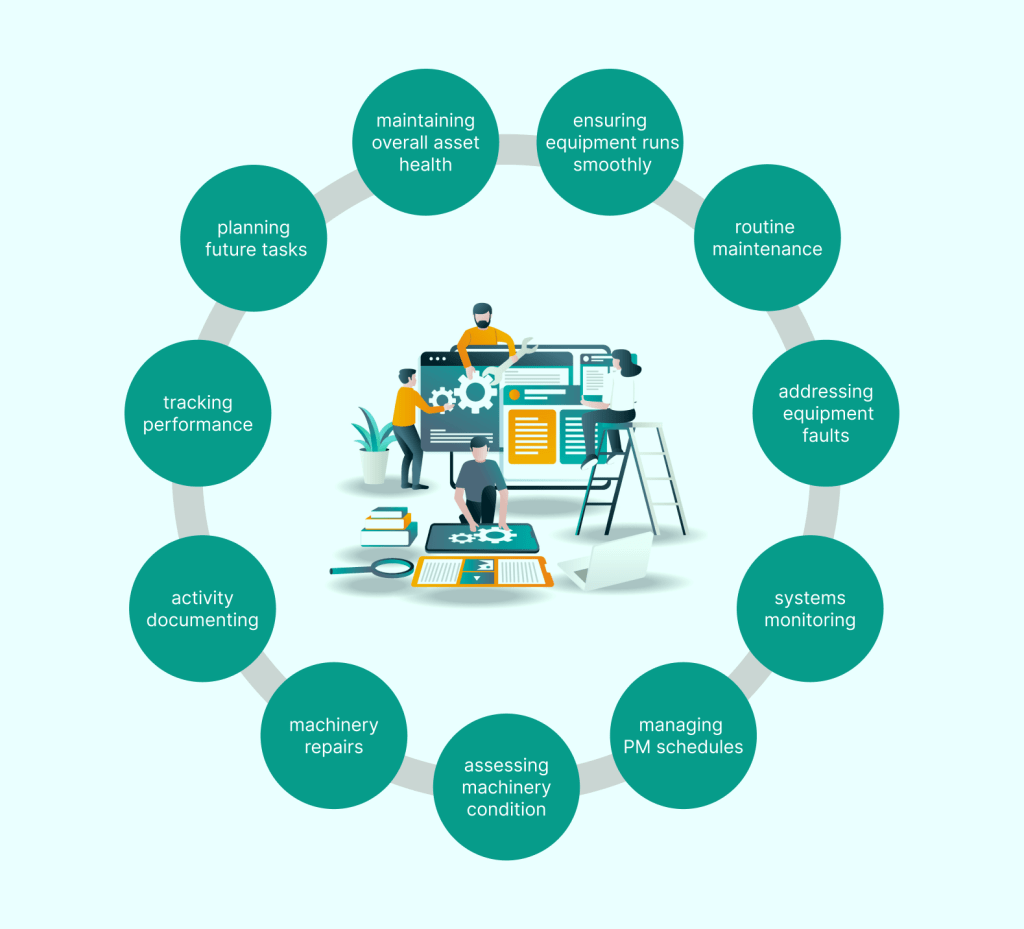
Source: WorkTrek
Impact on Facility Performance
Having a well-coordinated maintenance team can significantly boost your facility’s performance. By executing regular maintenance on critical assets, they minimize unexpected breakdowns and reduce downtime.
Effective maintenance strategies, such as preventive and proactive maintenance, also contribute to equipment longevity.
This improved maintenance strategy can delay the replacement of critical assets. This approach can optimize maintenance costs and improve safety and reliability in operations.
Maintenance Types: Preventive, Corrective, and Proactive
Preventive Maintenance (PM) involves regular inspections and servicing based on a schedule. The goal is to prevent failures before they occur. This includes lubricating parts, checking for wear, and replacing old components.
Corrective Maintenance occurs after a problem has been identified. This unplanned corrective maintenance approach deals with fixing issues as they arise. It is essential for unexpected faults that can’t be predicted or avoided beforehand, ensuring minimal downtime.
Proactive Maintenance focuses on predicting potential failures and addressing them before they happen. This includes advanced monitoring techniques and data analysis to foresee issues. It helps optimize maintenance operations and extend the lifespan of equipment. This approach can also help anticipate equipment failures.
These maintenance types create a comprehensive strategy to maintain your facility effectively.

Source: WorkTrek
Key Entities in Maintenance
The key entities included in property maintenance include maintenance managers and maintenance technicians.
Role of Maintenance Managers
Maintenance Managers are the responsible leaders for the facility management team. They coordinate all maintenance activities, including scheduling and ensuring the team follows the schedule efficiently. A significant part of their job is creating maintenance goals, providing safety equipment, and managing the budget.
These managers also handle the team’s training and development. This involves organizing workshops and updating the team on new technologies and methods.
They ensure the facility runs smoothly by reducing downtime and improving performance.
Moreover, Maintenance Managers must oversee safety protocols and ensure maintenance practices comply with industry standards and regulations.
Maintenance Technicians at Work
Maintenance Technicians are the backbone of the maintenance team. They perform day-to-day tasks such as inspecting equipment, performing repairs, and performing preventive maintenance. Their role focuses on the upkeep and repair of facility assets.
Technicians need to be well-versed in various technical skills, including knowledge of HVAC systems, electrical work, access control systems, and plumbing.
They should also communicate and document maintenance efforts and adhere to safety standards.
Regular training and hands-on experience enhance their skills, enabling them to handle complex issues.
Technicians also play a role in identifying potential problems. Early detection and resolution of issues help avoid significant downtime and costly repairs.
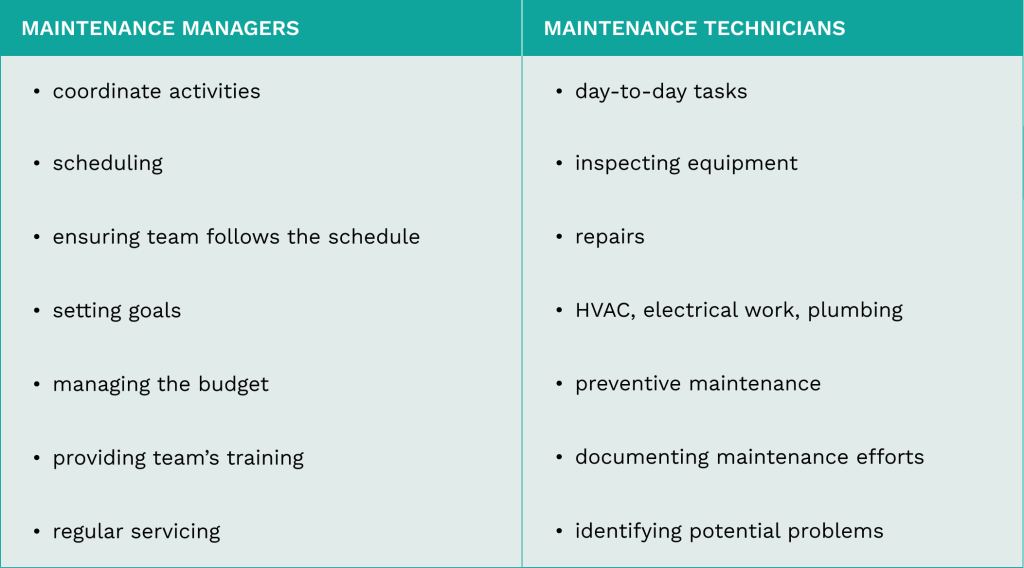
Source: WorkTrek
Communication and Coordination
Effective communication and coordination across the team are essential for a well-functioning team. During maintenance work, Microsoft Teams and Slack can provide optimized messaging between different parties.
Maintenance Managers must communicate regularly with technicians to assign tasks and provide updates on maintenance activities. Clear instructions and open channels help in executing the maintenance plan efficiently.
Implementing a modern CMMS platform can significantly enhance this communication between all parties involved in maintenance.
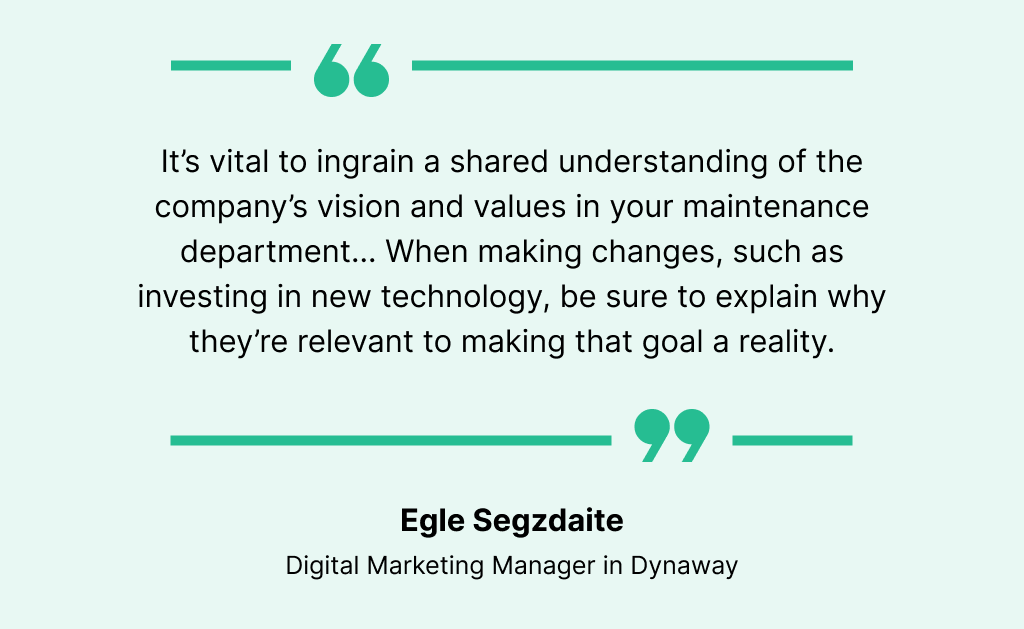
Illustration: WorkTrek / Quote: Dynaway
Regular Meetings
Team meetings, sometimes called daily standups, can significantly improve coordination. They facilitate sharing information about completed tasks, ongoing work, and plans, helping to identify bottlenecks and ensure everyone is on the same page.
Maintenance and Facility Safety
Keeping your facility safe involves ensuring compliance with safety standards and being prepared for emergency maintenance and response. Both aspects are crucial for the well-being of employees and the smooth operation of your facility.
Compliance with Safety Standards
Compliance with safety standards prevents accidents and ensures a safe working environment. Regular inspections are necessary to identify potential hazards.
Your facility maintenance team should be trained in safety protocols and understand the importance of adhering to regulations set by agencies like OSHA.
Your facility’s electrical systems, plumbing, and HVAC need ongoing checks. This includes checking for leaks or changing filters.
Preventive maintenance can reduce the risk of failures leading to unsafe conditions. Maintenance logs should be kept to track compliance and the status of safety inspections.
Using detailed checklists helps identify and address issues promptly. Moreover, ongoing training for the maintenance team on the latest safety standards can improve overall safety compliance.
Emergency Maintenance and Response
Emergency maintenance and response plans are vital for addressing unexpected issues that could impact safety. They are generally more expensive to perform and can increase maintenance costs.
These plans should clearly outline the steps during an emergency, such as equipment failures, fires, or chemical spills.
Regular emergency drills can help ensure everyone knows their roles during an emergency. Emergency lighting, backup power systems, and accessible emergency exits are essential.
Keeping an inventory of spare parts and emergency equipment can minimize downtime and maintain safety.
Additionally, a communication plan is necessary to inform all staff about procedures to follow during an emergency. This preparedness can significantly reduce the risks associated with unexpected maintenance issues.
Technological Integration
Integrating technology into your maintenance processes can significantly enhance efficiency and reliability. These tools offer valuable insights and streamline many tasks, from predictive maintenance to automated monitoring.
Computerized Maintenance Management Systems (CMMS)
CMMS is vital for modern maintenance teams. These systems help you document all maintenance activities, schedule tasks, and track equipment history. By using CMMS, you can predict when maintenance is needed, reducing unexpected downtime.
Features like asset management, work order tracking, and inventory control are central to CMMS. They let you plan and make informed decisions. Predictive maintenance also benefits from CMMS, as it helps you identify potential issues before they become problems.
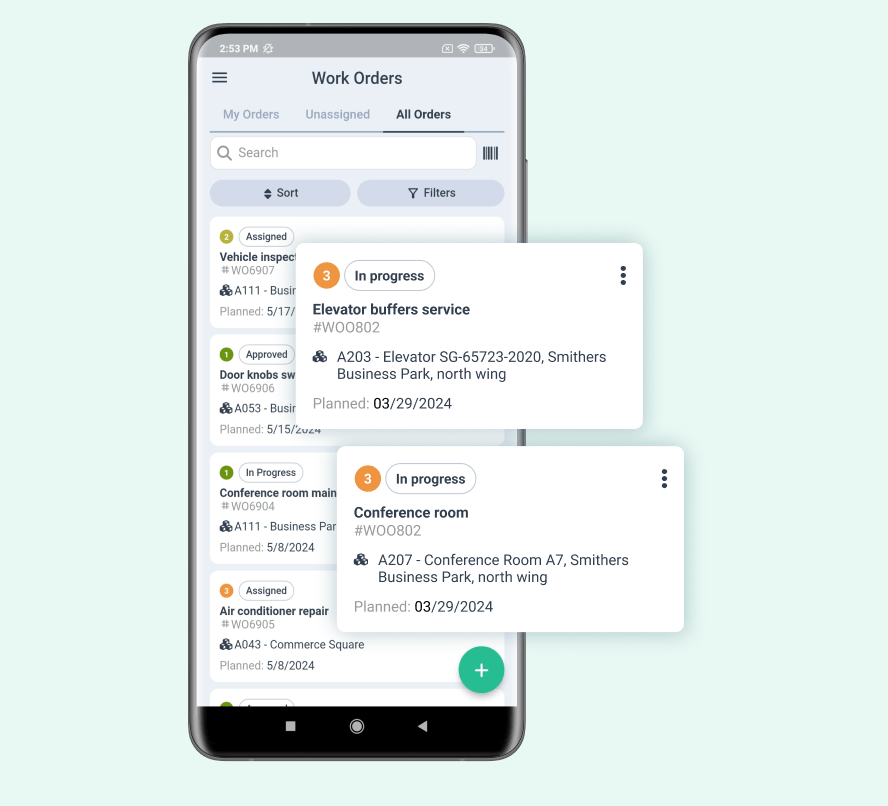
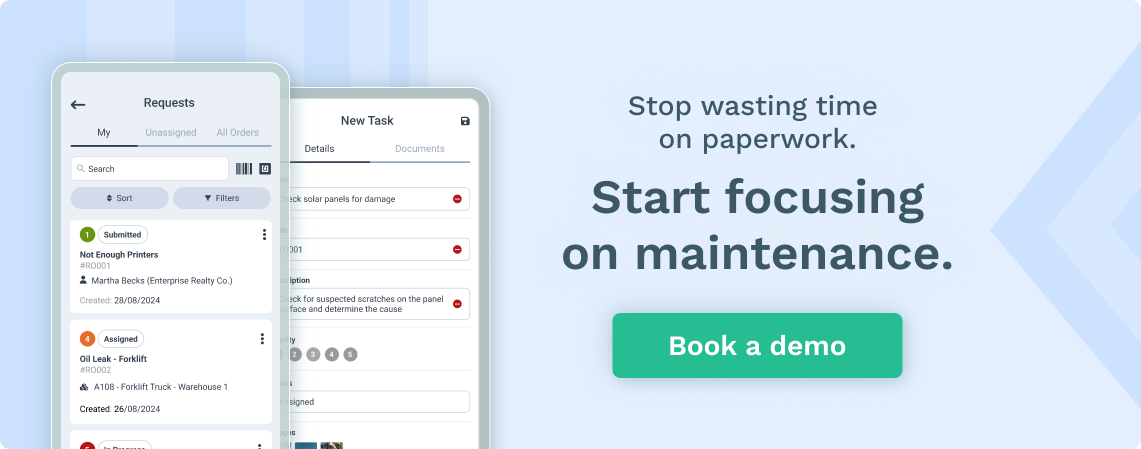
Source: WorkTrek
Monitoring Systems and Automation
Monitoring systems use sensors to track the status of equipment in real-time. IoT sensors, for instance, can monitor temperature, humidity, and vibration. This data is crucial for ensuring everything runs smoothly and proactively addressing issues.
Automation further enhances these systems by automatically adjusting settings or alerting you when something goes wrong. Integrating these tools can optimize performance, optimize maintenance costs, and reduce the need for manual checks. Real-time data allows for quicker responses and more efficient maintenance workflows.
Facility Management Software
Facility management software integrates various aspects of facility maintenance, covering tasks from routine maintenance to emergency repairs.
Worktrek includes a complete facility maintenance module to help you manage your facility. This software lets you organize everything by managing resources, tracking progress, and generating reports.
Functions like energy management and space utilization are often included, providing a comprehensive view of your facility’s operations. By centralizing information, facility management software ensures that all team members are on the same page, improving communication and efficiency.
Maintenance teams can better manage their responsibilities using these technologies and ensure the facility operates smoothly.
Maintenance Scheduling and Planning
Effective maintenance scheduling and planning ensure that maintenance tasks are completed efficiently and on time. By organizing tasks and resources ahead of time, you can minimize equipment downtime and maximize productivity.
Efficient Scheduling of Maintenance Tasks
Efficient scheduling can reduce maintenance delays. You must gather all necessary resources, including labor, parts, and tools. Planners coordinate these elements to ensure tasks follow a streamlined schedule.
Using a Computerized Maintenance Management System (CMMS) like WorkTrek can help. It automates the scheduling process, making it easier to track upcoming maintenance activities. Regular checklists help keep tasks on track, ensuring nothing is overlooked.
Communicate with your team to verify that all scheduled tasks are achievable within the given timeframe. This transparent communication helps prevent bottlenecks and unnecessary downtime. Efficient scheduling not only boosts productivity but also extends the lifespan of your equipment.
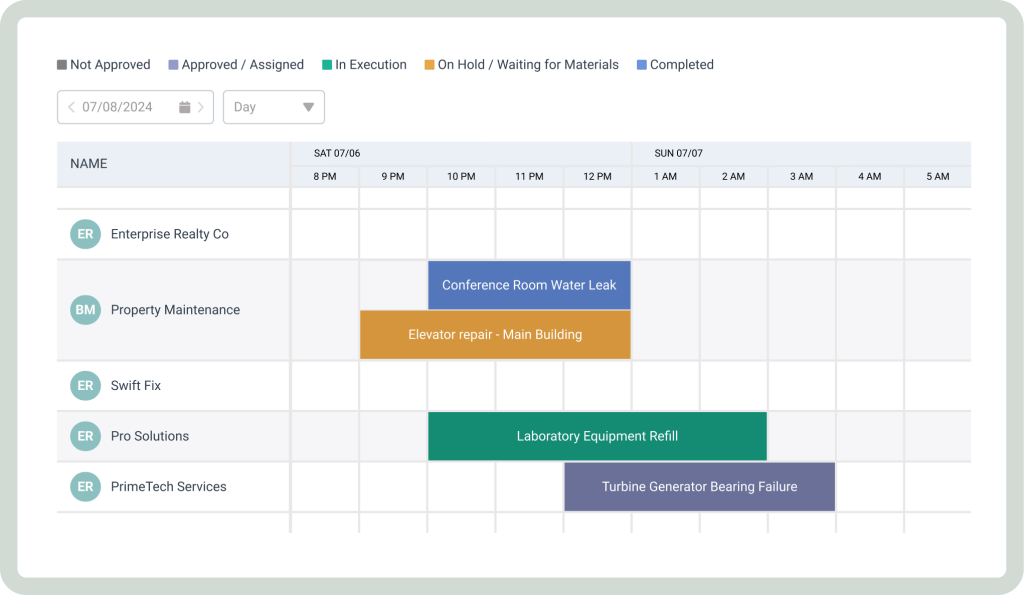
Source: WorkTrek
Strategic Planning and Forecasting
Strategic planning focuses on long-term goals. It involves analyzing equipment performance data to predict future maintenance needs. This proactive approach helps avoid unexpected failures by addressing potential issues before they become significant problems.
Forecasting is essential for resource allocation. Knowing when and what maintenance will be needed allows you to accurately budget for labor and parts. A well-thought-out maintenance plan can save money by preventing costly emergency repairs.
Involve all team members in the planning process. Their insights can provide valuable information that might be overlooked during data analysis. Regularly update the maintenance plan to adapt to changes in equipment usage and facility requirements, ensuring continued efficiency and reliability.
Maintenance for Various Facility Types
Different facilities have unique maintenance needs, from daily repairs to specialized tasks. Proper maintenance ensures longevity, safety, and optimal functionality.
Commercial, Industrial, and Residential Buildings
Maintenance in commercial buildings often includes HVAC system inspections, elevator checks, and pest control. Tasks like maintaining lighting, plumbing, and fire safety systems are routine. These buildings usually have high foot traffic, making regular upkeep essential to avoid disruptions.
For residential buildings, the focus is more on the comfort and safety of occupants. Typical tasks include plumbing repairs, electrical system inspections, and pest control. Landscaping and standard area maintenance, like cleaning hallways or repairing shared facilities, help keep the living environment pleasant and functional.
Specialized Facilities: HVAC and Electrical Systems
HVAC systems require regular inspections to ensure they operate efficiently. This includes checking air filters, cleaning ducts, and inspecting thermostats. Regular maintenance prevents breakdowns and ensures indoor air quality. Proper calibration and timely repairs extend the lifespan of HVAC units.
Electrical systems in any facility need routine checks to prevent hazards. This involves inspecting wiring, testing circuit breakers, and ensuring all electrical installations comply with safety standards. Regular maintenance helps prevent electrical fires and ensures the facility’s power supply remains stable and efficient.
For more details on the roles of different maintenance personnel, refer to the blog The Role of the Maintenance Team in Your Facility.
Optimizing Resource Management
Effective resource management is essential for the efficiency and productivity of your facility’s maintenance team. To maximize performance, focus on detailed inventory tracking and proper upkeep of capital and physical assets.
Effective Inventory Management
Efficient inventory management involves tracking and recording all maintenance supplies, tools, and parts. Accurate records ensure the right resources are available when needed, reducing downtime.
Use digital inventory systems to maintain real-time records. These systems can track item usage, forecast future needs, and alert you when stock is low.
Implementing an automated inventory process minimizes human error. Regular audits are also essential to verify stock levels and identify discrepancies.
Maintaining a detailed inventory database helps in better budgeting and resource allocation. It also aids in the quick identification of frequently used items, allowing for bulk purchasing and cost savings.
Maintenance of Capital and Physical Assets
Proper maintenance of capital and physical assets ensures longevity and reliable performance. Regular inspections and preventive maintenance schedules are key to avoiding unexpected failures.
Develop a comprehensive asset management plan that includes routine checks, servicing, and repairs. This plan should cover all assets, such as machinery, HVAC, and electrical systems, to maintain optimal operation.
WorkTrek can give you access to all your assets in a centralized area.
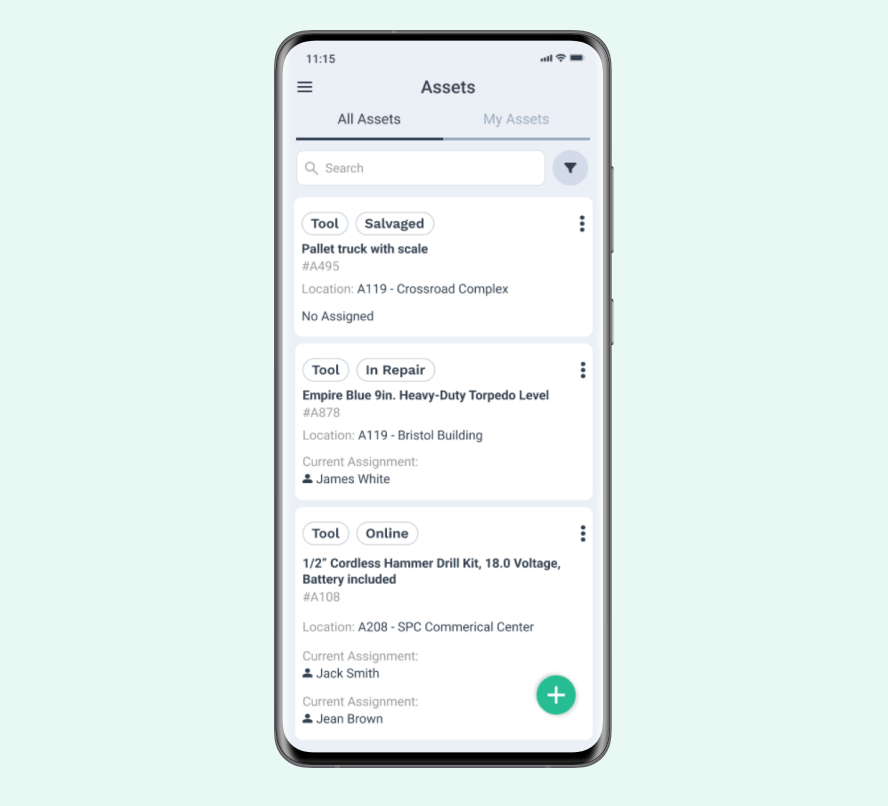
Source: WorkTrek
Use technology for asset tracking. Software solutions can schedule maintenance activities and log completed tasks, providing historical data for future reference.
Regular training for maintenance staff about new techniques and best practices ensures your team is well-equipped to handle asset maintenance. Investing in staff knowledge and modern tools can significantly extend the lifespan and functionality of your assets.
Review and update your maintenance strategies periodically. Staying current with technological advancements and industry standards is essential for maintaining the efficiency of capital and physical assets.
Quality and Performance Measurement
To maintain a high-quality and efficient facility, your maintenance team must monitor performance and regularly assess the health of equipment and infrastructure. This ensures reliability and minimizes equipment failure.
Key Performance Indicators (KPIs)
Key performance indicators (KPIs) are essential benchmarks for your maintenance team. They help measure how well your team achieves its maintenance goals. For instance, KPIs can include reducing downtime, cutting costs, and improving equipment reliability.
Specific KPIs like reducing unexpected downtime by 40% over 12 months can help you measure progress.
Leading KPIs give insights into future performance by showing trends and potential issues. In contrast, lagging KPIs reflect past performance and help verify whether goals were met. Tracking metrics such as these can effectively manage and optimize your facility’s maintenance.
Assessing Equipment and Infrastructure Health
It is critical to assess the health of your equipment and infrastructure regularly. This includes monitoring for any signs of wear and tear or equipment failure and ensuring all systems operate smoothly.
Maintenance metrics like Mean Time Between Failures (MTBF) and Mean Time to Repair (MTTR) are crucial. MTBF indicates how reliably equipment performs over time, while MTTR measures how quickly your team can repair it.
Using tools and software for maintenance analytics can help in these assessments. Implementing a robust system enables you to keep your facility running efficiently and minimizes unexpected failures.
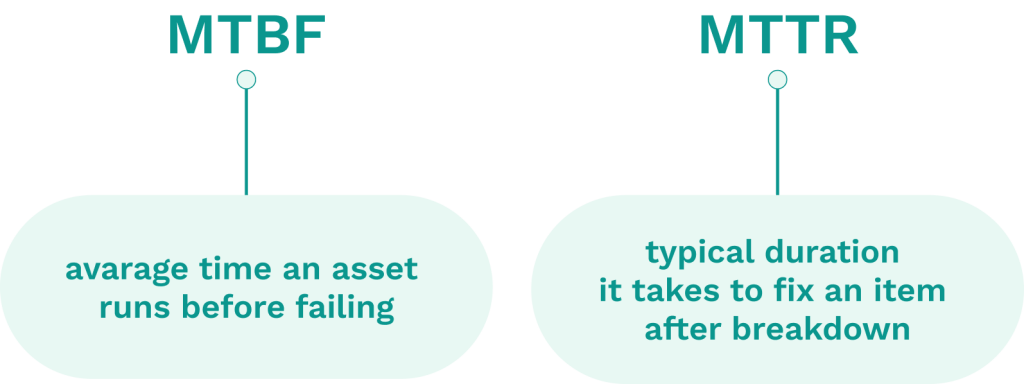
Source: WorkTrek
Working Environment and Culture
A positive working environment and a strong culture are crucial for an efficient maintenance team. Key areas include continuous education and practical problem-solving skills to ensure optimal upkeep and functionality.
Maintenance Team Culture and Education
Creating a solid maintenance culture starts with hiring the right professionals. Select individuals who inspire and guide the team and invest in continuous training to boost their skills.
Training programs should cover the latest maintenance techniques and safety protocols. Regular workshops and certifications keep the team up-to-date.
Fostering a collaborative atmosphere improves morale. Encourage open communication and feedback. Clearly defined mission and goals help focus efforts and align the team with the organization’s objectives, enhancing team cohesion and effectiveness.
Problem-solving and Technical Knowledge
Practical probletraiProvide access to manuals, tools, and up-to-date documentation. This support enables them to handle any situation. Conduct regular reviews and simulations of potential scenarios.
Empowering the team with decision-making authority boosts their confidence and efficiency. Continuous learning and adaptation to new problems build a resilient and competent maintenance team.
Standards and Procedures in Maintenance
Maintenance thrives when the facility manager defines clear standards and procedures. Following standard operating procedures and utilizing checklists ensures your maintenance team works efficiently and safely.
Adherence to Standard Operating Procedures
Standard Operating Procedures (SOPs) are key to consistent and efficient maintenance. They guide your team and provide step-by-step instructions for tasks.
This minimizes errors and enhances safety. When SOPs are well-documented, your team members know precisely what is expected.
Detailed SOPs also help train new staff quickly. They outline how tasks should be done and ensure everyone follows the same methods. This helps avoid misunderstandings and provides high-quality work. Regularly review and update your SOPs to keep them relevant to your facility’s needs. Keeping close attention to detail is essential for effective SOPs.
Utilizing Checklists for Quality Assurance
Checklists are vital tools for quality assurance in maintenance. They ensure that every step of a task is completed without missing anything. Digital checklists are handy because they are easy to update and can be accessed by everyone on your team.
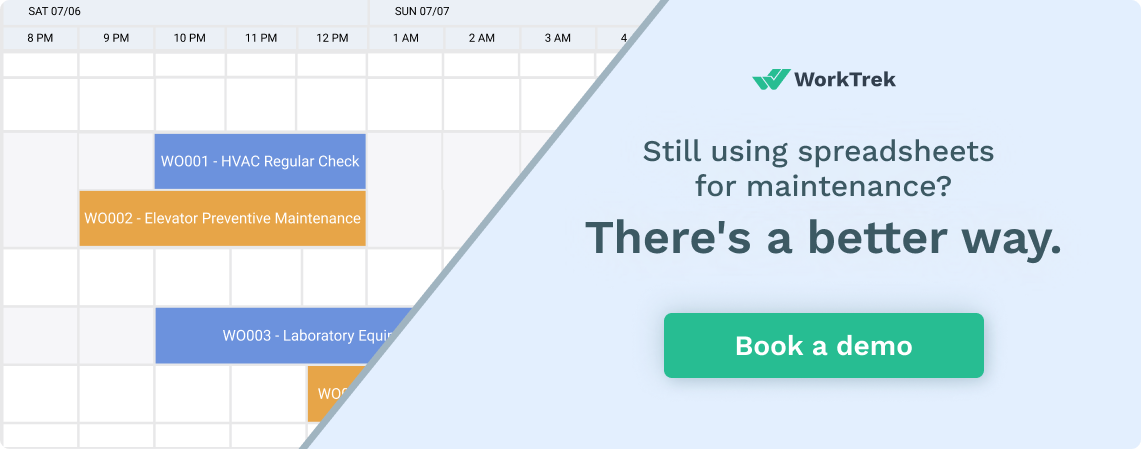
Using digital checklists can enhance your team’s ability to keep track of recurring tasks and document completion. They serve as a record of maintenance activities, making it easier to spot patterns and areas needing improvement.
Checklists promote accountability and ensure every maintenance task is performed thoroughly and correctly.
Sustainability and Energy Management
Implementing sustainable practices and focusing on energy management can significantly lower energy consumption and cut costs. This section explores how maintenance teams can effectively adopt these practices.
Sustainable Practices and Energy Conservation
Adopting sustainable practices in your facility involves integrating eco-friendly methods to conserve energy. Energy-efficient systems and technologies, such as LED lighting and smart thermostats, can reduce energy consumption. These technologies minimize waste and lower utility costs.
Another practice is optimizing the use of natural light through strategic placement of windows and skylights.
Proper insulation and regularly maintained HVAC systems also contribute to energy conservation. Don’t forget to use insulation for ducts.
Sustainable practices help reduce the carbon footprint and make your facility more cost-effective in the long run.
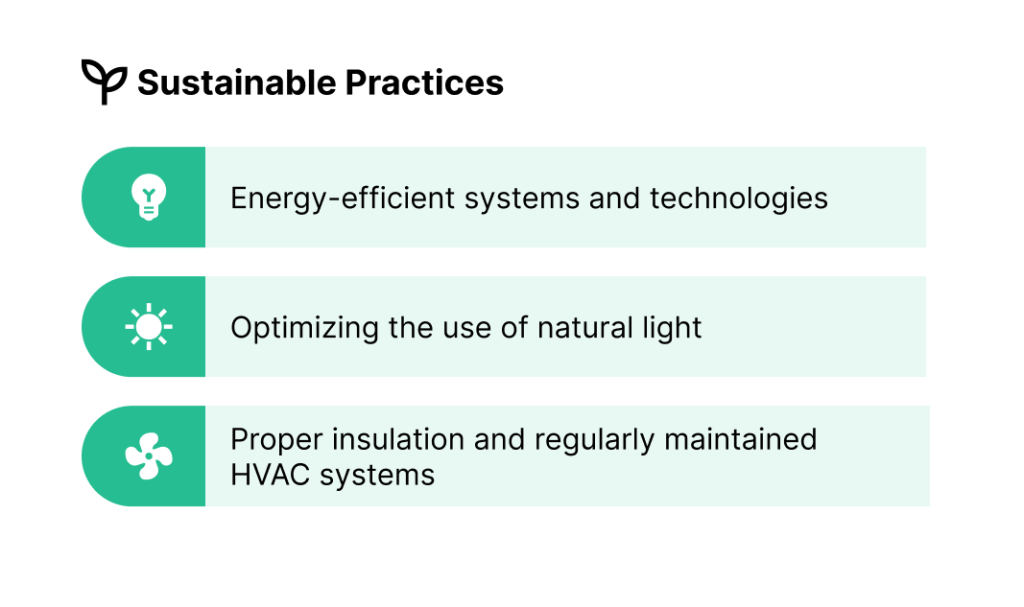
Source: WorkTrek
Maintenance Impact on Energy Consumption
The maintenance team plays a crucial role in managing energy consumption. Regular upkeep of equipment ensures that all systems operate efficiently. For instance, cleaning and servicing HVAC systems maintains their efficiency, preventing unnecessary energy use.
Scheduled inspections can identify and fix leaks, faulty wiring, or inefficient machinery that may waste energy. By adopting predictive maintenance strategies, your team can preemptively address potential issues, leading to smoother operations and reduced downtime. A well-maintained facility conserves energy and supports the organization’s overall sustainability goals.
Human Resources and Organizational Aspects
Effective human resource management is key to organizing and empowering your maintenance team. This section focuses on the critical role HR plays in staff hiring and training within the maintenance department.
Role in Staff Hiring and Training
Human resources play a pivotal role in hiring the right maintenance workers. They help define job descriptions, required skills, and experience levels. In collaboration with the maintenance supervisor and maintenance director, HR identifies candidates who best fit the team.
HR departments can also develop training programs for new employees. Both new hires and existing staff need continuous training to stay current on the latest techniques and safety protocols.
Regular training sessions include equipment handling, safety regulations, and skill enhancement. Coordination between HR and the training department ensures these sessions meet the team’s needs.
Key Points to Remember:
- HR defines job requirements.
- Collaboration with supervisors and directors.
- Continuous training improves safety and efficiency.
For more insights on closing the skills gap, you can explore ways to work with HR for facility maintenance.
Regulatory Compliance and Legal Considerations
Ensuring regulatory compliance in your facility’s maintenance operations is crucial. This includes adhering to local and national laws and maintaining safety standards to protect everyone involved.
Compliance with Regulations and Standards
Your maintenance team must stay informed about various regulations that affect facility management. This involves understanding and following laws regarding building codes, health and safety standards, and environmental regulations.
Regular risk assessments should be conducted to identify potential hazards and implement corrective actions for effective compliance.
Failure to comply can result in hefty fines and legal issues that could disrupt operations. Proper compliance and safety in building maintenance ensure the safety of occupants and protect property assets.
To manage compliance effectively, consider using compliance management systems that help track legal requirements and automate reporting tasks. This lets the team stay updated with regulatory changes, ensuring continuous oversight. Regular training sessions are essential to keep staff aware of current regulations and best practices for maintenance and security systems in the facility.
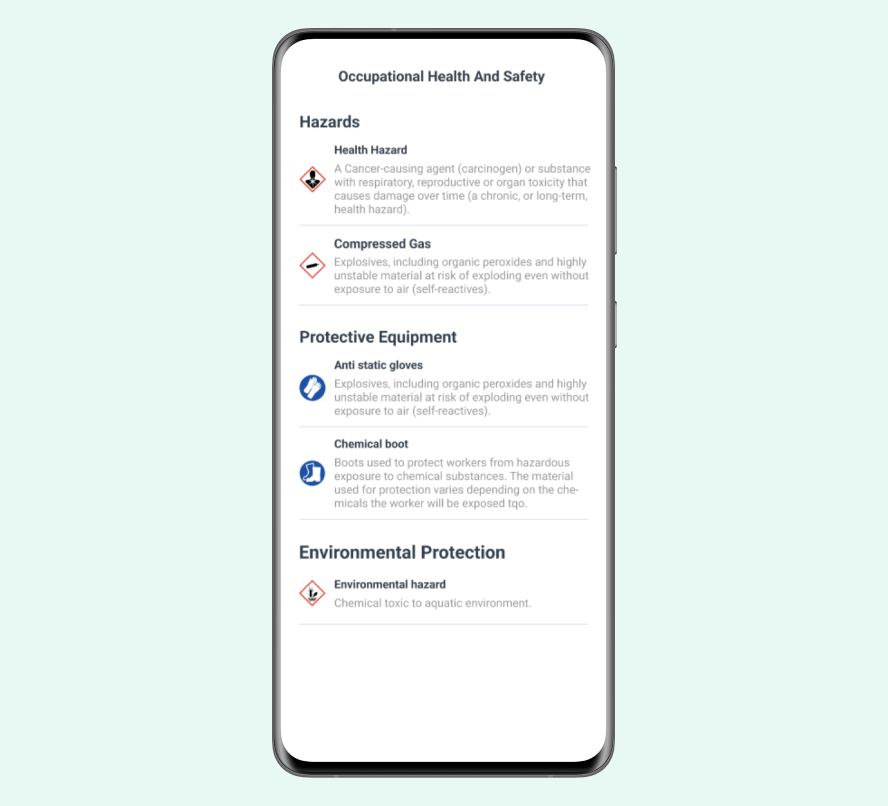
Source: WorkTrek
Evolving Practices in Facility Maintenance
Modern facility maintenance involves innovative practices and the use of advanced technologies. The need for efficiency, cost control, and improved asset management drives these changes.
Innovation and the Future Outlook
Innovative technologies have significantly advanced facility maintenance. One key development is integrating enterprise asset management (EAM) systems. These systems help track assets, schedule maintenance tasks, and forecast potential issues. Leveraging this technology ensures optimal performance and reduces downtime.
Lubrication and oil management are other crucial areas of innovation. Advanced monitoring tools now allow you to keep equipment well-lubricated and operating smoothly. Predictive maintenance techniques can alert you to potential failures before they happen, saving time and resources.
Looking ahead, the future of facility maintenance involves adopting cutting-edge tools and software to streamline processes. Implementing sensors and IoT devices can further automate and enhance maintenance tasks, making your facility more efficient and reliable. Embracing these evolving practices will place your facility at the forefront of operational success.
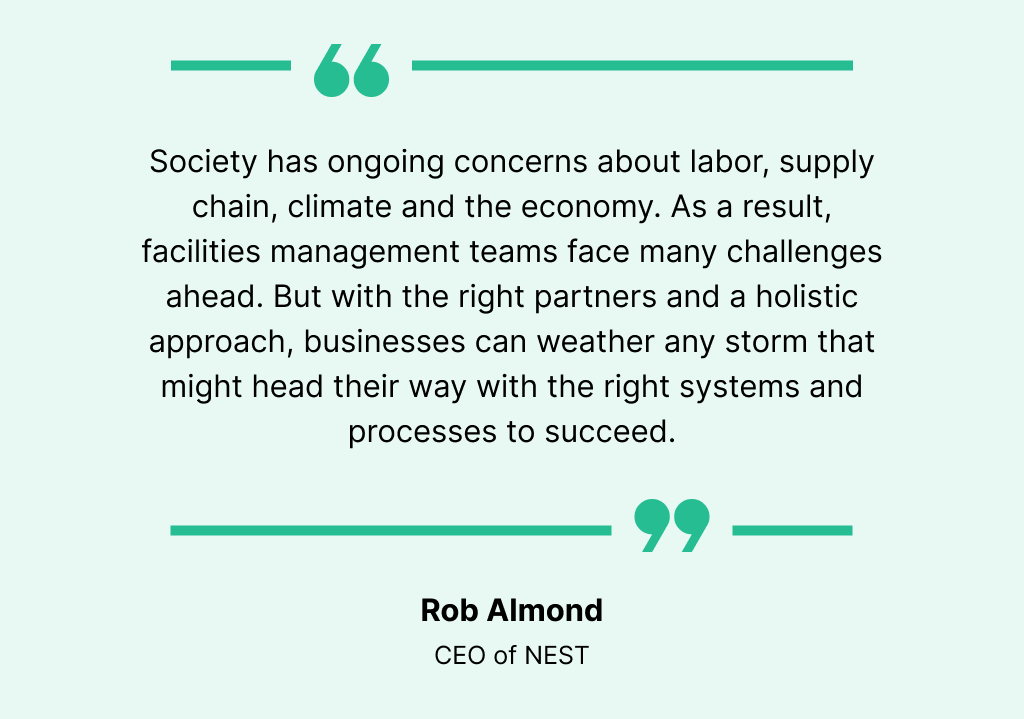
Illustration: WorkTrek / Quote: Forbes
Frequently Asked Questions
Understanding the roles and strategies of the maintenance team is crucial when managing a facility. Below, you’ll find answers to common questions about the responsibilities and structure of a maintenance department and strategies to enhance its effectiveness.
What are the key responsibilities of a maintenance department?
The maintenance department is responsible for planning, executing, and overseeing maintenance tasks. This includes preventive maintenance, repairs, and ensuring the smooth functioning of machinery and infrastructure. The department also manages the budget, supplies, and training needed for efficient operations.
How can the maintenance team structure in a facility enhance operational efficiency?
A well-structured maintenance team can significantly improve operational efficiency. Roles like Maintenance Planner and Director help coordinate efforts and set clear goals. Proper scheduling and task delegation can minimize downtime and ensure the timely completion of maintenance tasks.
What strategies can be implemented to improve the effectiveness of a maintenance department?
Implementing SMART goals can improve the effectiveness of your maintenance department. Hiring skilled technicians, providing continuous training, and using maintenance management software are also beneficial. Regular assessments and feedback can help identify areas for improvement.
In the context of facility management, what does ‘maintenance’ entail?
Maintenance in facility management includes routine inspections, preventive maintenance, and emergency repairs. It involves maintaining building systems and equipment to ensure they operate efficiently and safely. Tasks range from simple checks to complex system overhauls.
Can you give examples of everyday facility maintenance tasks?
Typical tasks include HVAC maintenance, electrical system checks, plumbing repairs, and general building upkeep. Regular inspections and lubrication of machinery, as well as replacing worn-out parts, are also typical. These tasks ensure the facility runs smoothly and prevent unexpected downtimes.
What is the significance of the maintenance department in a manufacturing company’s operations?
A manufacturing company’s maintenance department is vital for minimizing downtime and ensuring product quality. Proper equipment maintenance leads to fewer breakdowns and interruptions in the production line, directly contributing to the company’s operational efficiency and overall profitability.




